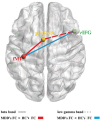Connectivity of the Frontal Cortical Oscillatory Dynamics Underlying Inhibitory Control During a Go/No-Go Task as a Predictive Biomarker in Major Depression
- PMID: 32848905
- PMCID: PMC7416643
- DOI: 10.3389/fpsyt.2020.00707
Connectivity of the Frontal Cortical Oscillatory Dynamics Underlying Inhibitory Control During a Go/No-Go Task as a Predictive Biomarker in Major Depression
Abstract
Background: Major depressive disorder (MDD) is characterized by core functional deficits in cognitive inhibition, which is crucial for emotion regulation. To assess the response to ruminative and negative mood states, it was hypothesized that MDD patients have prolonged disparities in the oscillatory dynamics of the frontal cortical regions across the life course of the disease.
Method: A "go/no-go" response inhibition paradigm was tested in 31 MDD patients and 19 age-matched healthy controls after magnetoencephalography (MEG) scanning. The use of minimum norm estimates (MNE) examined the changes of inhibitory control network which included the right inferior frontal gyrus (rIFG), pre-supplementary motor area (preSMA), and left primary motor cortex (lM1). The power spectrum (PS) within each node and the functional connectivity (FC) between nodes were compared between two groups. Furthermore, Pearson correlation was calculated to estimate the relationship between altered FC and clinical features.
Result: PS was significantly reduced in left motor and preSMA of MDD patients in both beta (13-30 Hz) and low gamma (30-50 Hz) bands. Compared to the HC group, the MDD group demonstrated higher connectivity between lM1 and preSMA in the beta band (t = 3.214, p = 0.002, FDR corrected) and showed reduced connectivity between preSMA and rIFG in the low gamma band (t = -2.612, p = 0.012, FDR corrected). The FC between lM1 and preSMA in the beta band was positively correlated with illness duration (r = 0.475, p = 0.005, FDR corrected), while the FC between preSMA and rIFG in the low gamma band was negatively correlated with illness duration (r = -0.509, p = 0.002, FDR corrected) and retardation factor scores (r = -0.288, p = 0.022, uncorrected).
Conclusion: In this study, a clinical neurophysiological signature of cognitive inhibition leading to sustained negative affect as well as functional non-recovery in MDD patients is highlighted. Duration of illness (DI) plays a key role in negative emotional processing, heighten rumination, impulsivity, and disinhibition.
Keywords: cognitive inhibition; functional connectivity (FC); go/no-go task; magnetoencephalography (MEG); major depressive disorder (MDD); power spectrum (PS).
Copyright © 2020 Han, Dai, Ridwan, Lin, Zhou, Wang, Yao and Lu.
Figures





Similar articles
-
Neural correlates of behavioral control and impulsivity in first-episode schizophrenia: A MEG-Based beta oscillation analysis.J Psychiatr Res. 2025 Jun 4;189:104-115. doi: 10.1016/j.jpsychires.2025.05.079. Online ahead of print. J Psychiatr Res. 2025. PMID: 40483844
-
Reorganization of cortical oscillatory dynamics underlying disinhibition in frontotemporal dementia.Brain. 2018 Aug 1;141(8):2486-2499. doi: 10.1093/brain/awy176. Brain. 2018. PMID: 29992242 Free PMC article.
-
Roles for the pre-supplementary motor area and the right inferior frontal gyrus in stopping action: electrophysiological responses and functional and structural connectivity.Neuroimage. 2012 Feb 1;59(3):2860-70. doi: 10.1016/j.neuroimage.2011.09.049. Epub 2011 Sep 29. Neuroimage. 2012. PMID: 21979383 Free PMC article.
-
Association of spatiotemporal interaction of gamma oscillations with heart rate variability during response inhibition processing in patients with major depressive disorder: An MEG study.Neuroimage. 2025 May 15;312:121234. doi: 10.1016/j.neuroimage.2025.121234. Epub 2025 Apr 24. Neuroimage. 2025. PMID: 40286828
-
Inhibitory Control Development: A Network Neuroscience Perspective.Front Psychol. 2022 Oct 10;13:651547. doi: 10.3389/fpsyg.2022.651547. eCollection 2022. Front Psychol. 2022. PMID: 36300046 Free PMC article.
Cited by
-
The effect of unilateral hand muscle contraction on frontal alpha asymmetry and inhibitory control in intrinsic reward contexts, a randomized controlled trial.Sci Rep. 2024 Nov 8;14(1):27289. doi: 10.1038/s41598-024-74070-8. Sci Rep. 2024. PMID: 39516208 Free PMC article. Clinical Trial.
-
Paranormal believers show reduced resting EEG beta band oscillations and inhibitory control than skeptics.Sci Rep. 2023 Feb 24;13(1):3258. doi: 10.1038/s41598-023-30457-7. Sci Rep. 2023. PMID: 36828909 Free PMC article.
-
Attenuated post-movement beta rebound reflects psychomotor alterations in major depressive disorder during a simple visuomotor task: a MEG study.BMC Psychiatry. 2023 Jun 3;23(1):395. doi: 10.1186/s12888-023-04844-3. BMC Psychiatry. 2023. PMID: 37270511 Free PMC article.
-
Resting-State Electroencephalogram (EEG) Coherence Over Frontal Regions in Paranormal Beliefs.Basic Clin Neurosci. 2022 Jul-Aug;13(4):573-584. doi: 10.32598/bcn.2021.923.2. Epub 2022 Jul 1. Basic Clin Neurosci. 2022. PMID: 36561241 Free PMC article.
-
Modulation of Functional Connectivity in Response to Mirror Visual Feedback in Stroke Survivors: An MEG Study.Brain Sci. 2021 Sep 28;11(10):1284. doi: 10.3390/brainsci11101284. Brain Sci. 2021. PMID: 34679347 Free PMC article.
References
-
- Joormann J, Yoon KL, Zetsche U. Cognitive inhibition in depression. Appl Preventive Psychol (2007) 12(3):128–39. 10.1016/j.appsy.2007.09.002 - DOI
LinkOut - more resources
Full Text Sources

